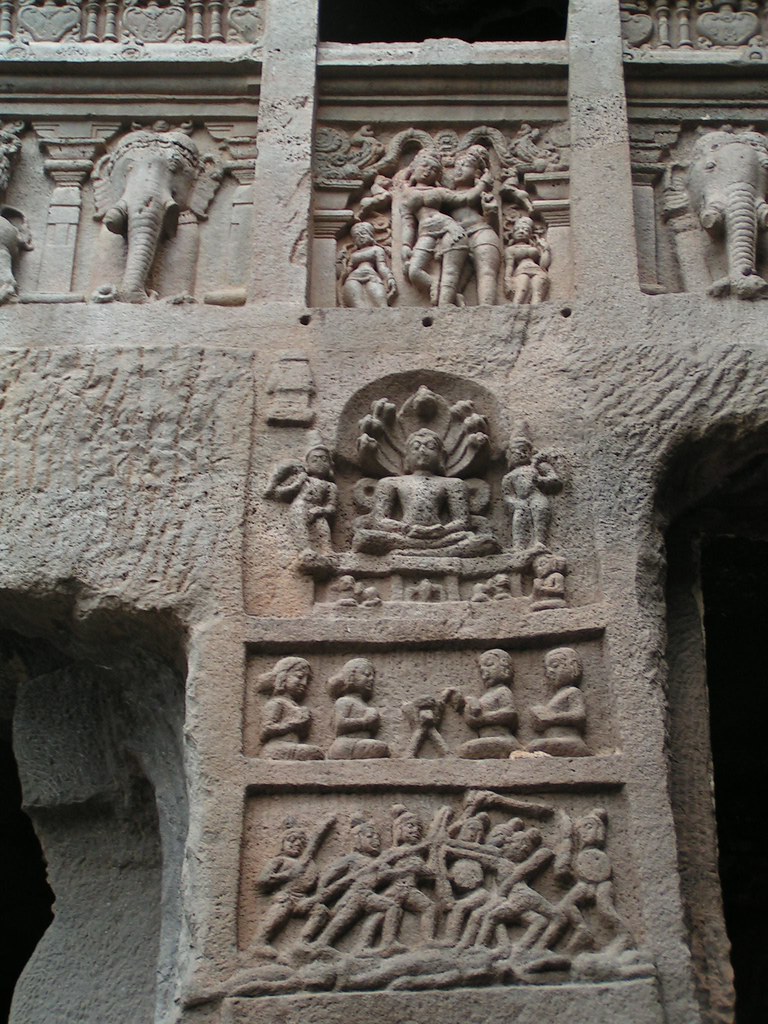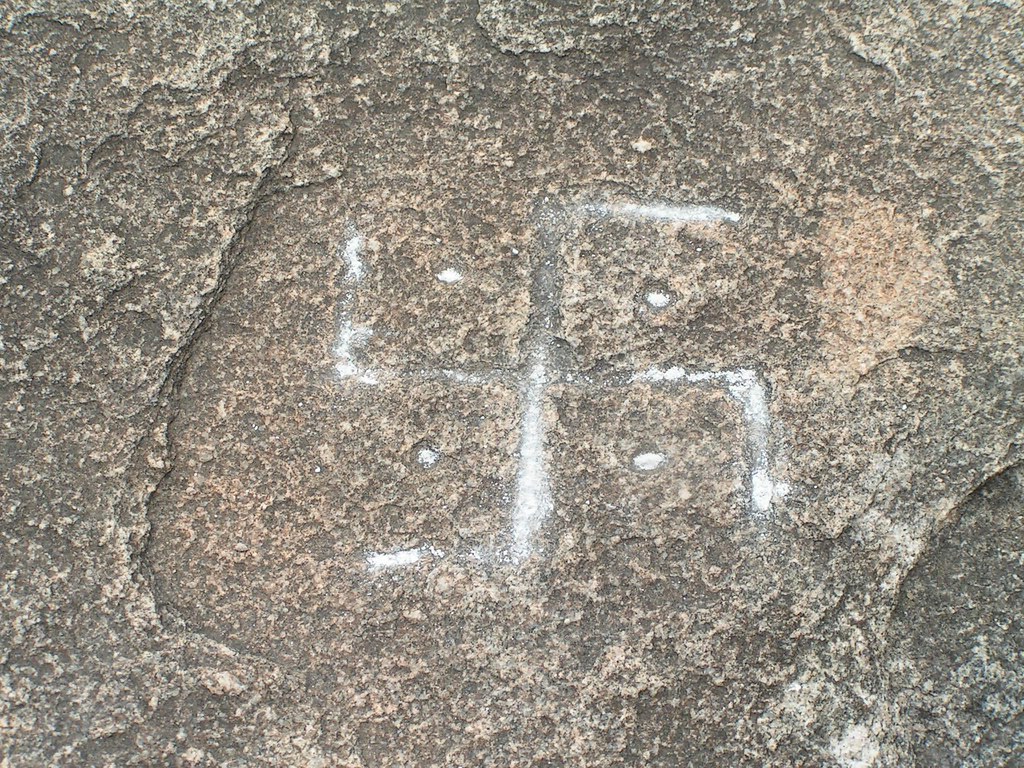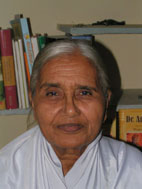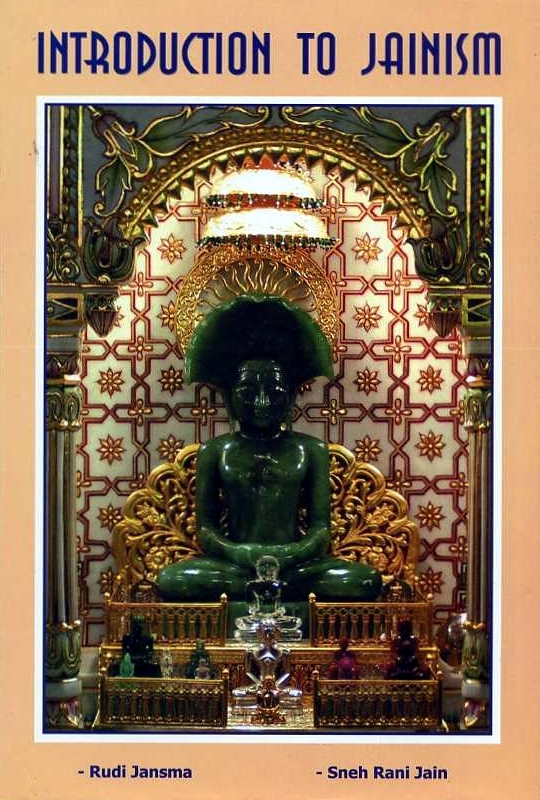After bidding farewell to the naked ascetics we visited the sacred mountain named Muktagiri. We arrived in the early evening and the spectacle was beautiful. The low sun threw most of the green fields into the shadow, but the peaks and summits, studded everywhere with large and small temples on which the reddish sun was shining, stood out against the immaculate azure sky. This mountain is a very sacred place for the Jains. Advanced ascetics go finally to this place to leave their physical bodies, ideally for the last time, and enter siddhaloka – the universe of those who have accomplished the path. Few outsiders know where to find this mountain.
One peculiarity of this mountain is that somewhere on it is a small shrine, and in it an icon of the last-but-one Tīrthamkara, Parśvanāth, who lived about 2900 years ago. He is always depicted with a cap of seven (or more) cobra heads because during his life he was protected by the serpent-god Dharanendra. The fact is that this image is visited daily by a living cobra, a life size-cobra, which moves around the statue trice and then sometimes climbs on top of it. Apparently this snake is worshiping Parśvanāth. The Jains explained this by supposing that this snake may have been a human in his former life, someone who had strong devotional feelings for Parśvanāth and perhaps had spent his or her life praying to him. But specific karma which the soul of that person – now the snake – still had to work out had made him incarnate in this form. Jains believe that it is possible for a human after his death to be reborn on earth as an animal, plant, or even a microorganism or mineral as the result of particular wrong-doings. If this is true, the higher aspects of the ex-human of course remain “elsewhere” in latency. When all these karmas have had their specific effect, one can be reborn as a human and pursue the noble path or neglect it, followed by a matching result. When we visited the shrine the snake wasn’t at home. I would have loved to take a picture. But somebody had a photo. We were taken to a house, where we were met by a very unpleasant old man. He had a discolored photo of the icon with the snake hanging in a frame on the wall. We were allowed to see it. But take a picture of it … never!!!!!!! Even the great guru Āchāryaji himself he would not allow that. And so we learned that the desire for an occult phenomenon can get so much hold on a man that he turns maliciously against the real thing: the guru is for everyone a living example of the highest detachment and ethics. So another opportunity to record a real miracle for science had been lost.
Our aim was to prove that the so-called Indus script and Indus culture, whose remnants are mainly found in the region of Harappa and Mohenjo-daro in Pakistan, was once spread out all over India. Therefore we had to visit remote places for very ancient scriptural signs and expressions of art. And those were found and photographed. It is remarkable that the diseased and 68- year old Brahmāchārinī had begun her research only five years before I met her. She had been a devotee of the Digambaras or gymnosophists for decades though. She told me that someone taught her the Indus script in a dream. The next day she opened “by chance” a book: the page at which it opened showed exactly those signs! They were depictions of ancient sacred signs, but not pictographic or phonetic signs; they were not an early form of Sanskrit, as some have tried to claim, but symbols which can only be understood by the Digambaras. She started her research. Her intuition, supported by her trained microbiologist’s eyes, constantly helped her to recognize the weathered inscriptions and read them. She traveled through most of India. Now she has deciphered the whole script and can read it. Moreover it appears by to occur all over India – something which formal archeology had not previously noticed. Most engravings tell about the individual course of life and dying of monks. She herself does not know exactly how this dream and the intuitions have been able to manifest. Perhaps a reawakened memory of a former existence? But from a Jain philosophical point of view the most logical explanation is that someone who has passed away many centuries ago, and who lived in the days the inscriptions were made, made them known to her in detail. The time has now arrived for a person fit for that task to bring this knowledge to humanity again. Her books will send shock waves through the world of archeology; perhaps she will make bitter enemies, and everything will be done to sweep her ideas under the carpet. Therefore it is important to proceed carefully and thoroughly.
We visited the famous caves of Ellora east of Mumbai. There are 34 numbered caves, Hindu, Buddhist as well as Jain. In those days these religions must have lived side by side in brotherhood. That has not always been the case. A relief on a wall of the Kailasa temple – which was entirely hacked out of the bedrock – seems to show that Jains were tortured by Hindus, and who danced on the corpses of the monks (photo 6). In view of their non-violent attitude it was easier for the Jains to leave their present body than to defend themselves with weapons.
 Jain monks are trampled on by Hindus; Kailas temple, Ellora
Jain monks are trampled on by Hindus; Kailas temple, Ellora
Our next destination was Śravana Belagola (or Sravanbelgol), the famous place of pilgrimage deep within Karnataka – not unknown by the more adventurous type of tourist – where on top of the highest hill, the Vindhyagiri, stands a 27 meter high and still totally undamaged and unweathered granite Bāhubali more then a thousand years old – it was inaugurated on March 13, 981 to be precise. The statue is also known as Śri Gomateśvar. This monolith has not been placed there, but the people living there a thousand years ago hacked away the granite mountain top until the image remained.
Scattered over the mountain there are engravings depicting two feet. These were made through the millennia, each time a monk took sallekhana – voluntary fasting until peaceful death.
The other mountain is known as the Chandra Hill, because the famous Indian emperor Chandragupta Maurya, grandfather of the equally famous Aśoka, lived and died there hundreds of years before Christ. One temple at least existed before Chandragupta arrived. His life has been depicted in 90 panels in two screens in the temple where the icons worshiped by the emperor himself still stand. Chandragupta was a great and powerful sovereign (see chapter 10). But one day he gave up all his wealth and earthly ties. He removed his jewelry and his clothes. The rest of his life he spent as a naked Jain monk. But even more interesting for us were the inscriptions on the rocks. These will be discussed in Chapter 10. Many thousands of years ago Jains must already have lived there, long before Tīrthamkara Mahāvīra, who lived 2500 years ago in North India. They lived in the same way as the monks in the monasteries today, and they died in the same way. What became of their souls after they had left their bodies behind on these rocks? What will become of the souls of those who do the same in our day? We will have to travel the path ourselves to answer this question (photo 7).
 Śvastika: Symbol of the four conditions in which the soul can exist. Vindhyagiri
Śvastika: Symbol of the four conditions in which the soul can exist. Vindhyagiri
 Dr. Sneh Rani Jain
Dr. Sneh Rani Jain
 Publisher:
Publisher: